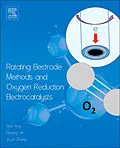Presents a comprehensive description, from fundamentals to applications, of catalyzed oxygen reduction reaction and its mechanisms
Portrays a complete description of the RDE (Rotating Disc Electrode)/RRDE (Rotating Ring-Disc Electrode) techniques and their use in evaluating ORR (Oxygen Reduction Reaction) catalysts
Provides working examples along with figures, tables, photos and a comprehensive list of references to help understanding of the principles involved
Dr. Wei Xing is a Professor and Dean at the Advanced Chemical Power Sources, Changchun Institute of Applied Chemistry, Chinese Academy of Sciences (CIAC-CAS). Prof. Xing received his PhD in Electrochemistry from CIAC-CAS in 1987, since then, as one of the key senior researchers, he established, and continues to lead the Laboratory of Advanced Power Sources at CIAC-CAS, that develops novel proton exchange membrane fuel cells (PEMFC) catalysts and technologies. His research is mainly concentrated on the R&D of fuel cell technologies including PEMFCs, direct methanol fuel cells (DMFCs), direct formic acid fuel cells (DFAFCs), in which cathode catalyst development for oxygen reduction reaction is the major focus. To date, he has published more than 160 referred journal papers, 3 books, 39 patents. Dr. Xing's research and scientific contributions are internationally recognized.
Rotating Electrode Methods and Oxygen Reduction Electrocatalysts provides the latest information and methodologies of rotating disk electrode and rotating ring-disk electrode (RDE/RRDE) and oxygen reduction reaction (ORR). It is an ideal reference for undergraduate and graduate students, scientists, and engineers who work in the areas of energy, electrochemistry science and technology, fuel cells, and other electrochemical systems. - Presents a comprehensive description, from fundamentals to applications, of catalyzed oxygen reduction reaction and its mechanisms - Portrays a complete description of the RDE (Rotating Disc Electrode)/RRDE (Rotating Ring-Disc Electrode) techniques and their use in evaluating ORR (Oxygen Reduction Reaction) catalysts - Provides working examples along with figures, tables, photos and a comprehensive list of references to help understanding of the principles involved
Autorentext
Dr. Wei Xing is a Professor and Dean at the Advanced Chemical Power Sources, Changchun Institute of Applied Chemistry, Chinese Academy of Sciences (CIAC-CAS). Prof. Xing received his PhD in Electrochemistry from CIAC-CAS in 1987, since then, as one of the key senior researchers, he established, and continues to lead the Laboratory of Advanced Power Sources at CIAC-CAS, that develops novel proton exchange membrane fuel cells (PEMFC) catalysts and technologies. His research is mainly concentrated on the R&D of fuel cell technologies including PEMFCs, direct methanol fuel cells (DMFCs), direct formic acid fuel cells (DFAFCs), in which cathode catalyst development for oxygen reduction reaction is the major focus. To date, he has published more than 160 referred journal papers, 3 books, 39 patents. Dr. Xing's research and scientific contributions are internationally recognized.
Klappentext
Rotating Electrode Methods and Oxygen Reduction Electrocatalysts provides the latest information and methodologies of rotating disk electrode and rotating ring-disk electrode (RDE/RRDE) and oxygen reduction reaction (ORR). It is an ideal reference for undergraduate and graduate students, scientists, and engineers who work in the areas of energy, electrochemistry science and technology, fuel cells, and other electrochemical systems.
- Presents a comprehensive description, from fundamentals to applications, of catalyzed oxygen reduction reaction and its mechanisms
- Portrays a complete description of the RDE (Rotating Disc Electrode)/RRDE (Rotating Ring-Disc Electrode) techniques and their use in evaluating ORR (Oxygen Reduction Reaction) catalysts
- Provides working examples along with figures, tables, photos and a comprehensive list of references to help understanding of the principles involved
Leseprobe
2 Electrode Kinetics of Electron-Transfer Reaction and Reactant Transport in Electrolyte Solution
WeiweiCaia,bXiaoZhaoa,bChangpengLiubWeiXingaJiujunZhangc aState Key Laboratory of Electroanalytical Chemistry, Changchun Institute of Applied Chemistry, Changchun, PR China bLaboratory of Advanced Power Sources, Changchun Institute of Applied Chemistry, Changchun, PR China cEnergy, Mining and Environment, National Research Council of Canada, Vancouver, BC, Canada Abstract
In this chapter, to facilitate understanding and preparing the basic knowledge for rotating electrode theory, both the electron-transfer and reactant transport theories at the interface of electrode/electrolyte are presented. Regarding the reactant transport, three transportation modes such as diffusion, migration, and convection are described. A focusing discussion is given to the reactant diffusion near the electrode surface using both Fick's first and second laws. In addition, based on the approach in literature, the kinetics of reactant transport near and within a porous matrix electrode layer and its effect on the electron-transfer process is also presented using a simple equivalent electrode/electrolyte interface.
KeywordElectrolyte solutionElectrochemical theoryElectrode reaction kineticsMass-transfer processOxygen reduction reaction (ORR)Oxygen solubilityRotating disk electrode (RDE)Rotating ring-disk electrode (RRDE)
Chapter Outline
2.1. Introduction?34
2.2. Kinetics of Electrode Electron-Transfer Reaction?34
2.2.1. Fundamental Chemical Reaction Kinetics?34
2.2.2. Fundamentals of Electrode Reactions (Bulter Volmer Equation)?35
2.3. Kinetics of Reactant Mass Transport Near Electrode Surface?44
2.3.1. Three Types of Reactant Transport in Electrolyte (Diffusion, Convection, and Migration)?45
2.3.2. Nonsteady-State Diffusion Process of Reactant when the Electrolyte Solution at the Static State?48
2.3.3. Steady-State Diffusion Convection Process of Reactant?54
2.4. Effect of Reactant Transport on the Electrode Kinetics of Electron-Transfer Reaction?57
2.4.1. Effect of Reactant Transport on the Kinetics of Electron-Transfer Process?57
2.4.2. Effect of Reactant Transport on the Thermodynamics of Electrode Reaction?59
2.5. Kinetics of Reactant Transport Near and within Porous Matrix Electrode Layer?61
2.6. Chapter Summary?64
References?64
IntroductionThe current density measured from the rotating electrode is contributed by both the current densities of electrode electron-transfer reaction and the reactant diffusion. In order to obtain the kinetic parameters of these two processes and their associated reaction mechanisms based on the experiment data, both the theories of electrode electron-transfer reaction and reactant diffusion should be studied and understood. In this chapter, the general theories for electrode kinetics of electron-transfer reaction and reactant diffusion will be given in a detailed level, and we hope these theories will form a solid knowledge for a continuing study in the following chapters of this book. Kinetics of Electrode Electron-Transfer Reaction
Electrochemical (or electrode) reaction kinetics is one kind of the chemical reaction kinetics. To obtain a better underst…
